What is the Ideal Grow Light for Your Situation?
| Lesson 1 | The Quick Guide to LED Grow Lights |
| Lesson 2 | All the light science you need to know to grow a plant |
| Lesson 3 | Is an LED light ideal for your situation? (The truth is LED’s aren’t always the best fit) |
| Lesson 4 | Qualities of Good LED Grow Lights |
| Lesson 5 | Read My Recommendations and Reviews |
![]()
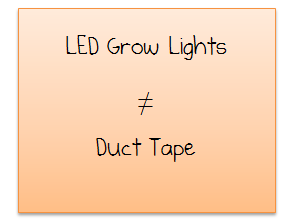
Duct tape is the universal problem solver; LED grow lights aren’t.
I would be flat-out lying to you if I told you that LED grow lights are the best for every grower’s situation. The purpose of this article is not to persuade you to buy an LED. I want to provide you with the facts and then I want you to decide what best fits your situation. Note that I expect many people to read this article and determine that a traditional HID light is a better fit for them than an LED. That’s okay with me; my goal is to help those people who have a situation where an LED light is the best fit. I can’t help them, if I can’t find them.
Let’s start out by listing some of the advantages and disadvantages of LED lights. After that, we’ll look at some common situations and I’ll give my personal recommendation about which type of grow light you should use.
Disadvantages of LEDs
Normally people start out with advantages, but let’s start out with the disadvantages of LED grow lights.
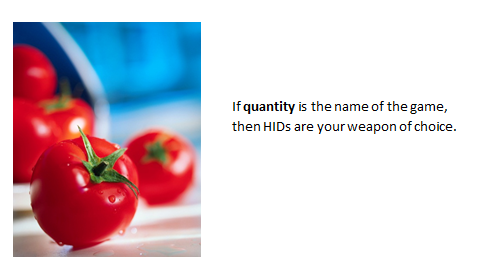
- Plants grown under traditional growing lights produce more vegetables. Yes, I said it. I don’t own an LED shop so I’m not afraid to admit that as of today traditional High-Intensity Discharge grow lights (all other things held equal) produce greater results than LED lights. There have been numerous unbiased case studies that show this on many different types of grows. If all you want is quantity, then please, please purchase a traditional High-Intensity Discharge (HID) grow light (Metallic Halide or High Pressure Sodium lights are the weapons of choice).
- Initial price is another disadvantage of LED grow lights. You’ll need to pay at least $200 to get a decent LED grow light. These up-front costs are a tough pill to swallow for many people (and rightfully so).
Advantages of LED Grow Lights
- LED technology is improving rapidly. One of the main disadvantages of LED lighting is that they don’t yield as much (watt per watt) as HID lights. I still believe this to be true, but the gap has closed significantly. A year ago when I read comparison tests of HIDs versus LEDs, the HIDs yielded quite a bit more. Nowadays the comparison tests seem to only give the HIDs a slight advantage and I’m even starting to see some side-by-side testing where LEDs are yielding more. For now, I still think HIDs yield more, but LED technology is improving and HID technology is staying the same.
- LED Prices are lowering. The other main disadvantage of LEDs is initial price. There’s no getting around it, LED grow lights are more expensive up front than traditional HIDs. The good news is that prices are dropping rapidly. The CEO of Philips Lighting estimates that the cost of LED lighting will drop by 50% sometime in the next five years (source). Recent news releases have shown that prices have already dropped by 50% over the last six months (source).
- The #1 advantage right now for LED lights is their lack of heat. LEDs put out less heat than traditional HID lights do (by quite a large margin). Most people using grow lights are growing indoors. When you’re growing indoors, managing heat can be challenging. I find it tiresome to set up some sort of ventilation system in order to accommodate HID lights. It’s not impossible to set up a proper ventilation system for HIDs, but it will cost you time and money (and in my case a few swear words and headaches).
- HID lights have on occasion burned some plants down (and houses for that matter). You need to consider fire safety when using HID lights. LED lights put out so little heat that some people have their LED lights touching their plants without any impact. I personally rest easier leaving my house with LEDs instead of HIDs.
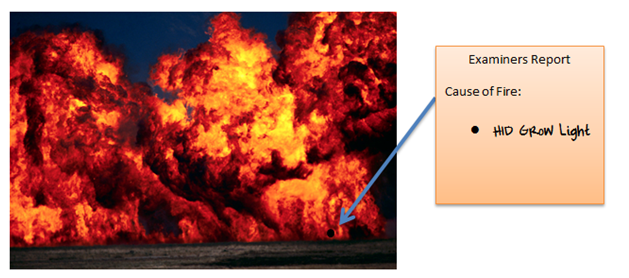
- You can plug LEDs right into your wall outlet. LED lights don’t require a ballast. Having a ballast isn’t a huge deal, but it’s nice to avoid the extra equipment and cords. It’s just one less thing to worry about!
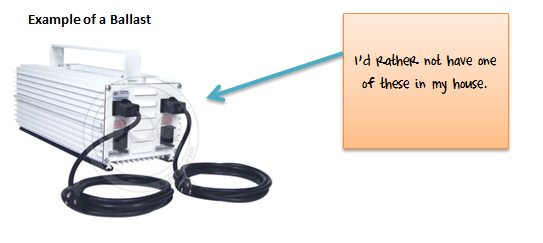
- LED grow lights last longer. How much longer is a subject of some debate (and it depends on the quality of light). Even the fiercest critics agree that LEDs last longer than HIDs.
- There are a lot of energy savings that come from using LEDs. The lights themselves are more efficient and don’t require as much electricity. In addition, you don’t need to run your air-conditioning and/or fans as much with these lights because they don’t produce as much heat. Finally, because the plants aren’t as hot they don’t need as much water. In other words, your heating, electricity, and water bills will go down using LEDs.
- Some people estimate that over the long run LEDs are cheaper than HIDs because of the amount of money they save on energy bills. Though I hate to say it, this is probably an exaggeration in some cases and it is probably true in others.
- The last advantage I’ll mention is maintenance and repair. Some people love to spend their time tinkering and fixing stuff. It’s an admirable trait (one that I wish I had). Unfortunately for me I’m the type of guy who just likes stuff to keep working (without having to repair it). LEDs are a better fit for people who don’t like having to fix stuff on a regular basis. They last longer and don’t require as much maintenance.
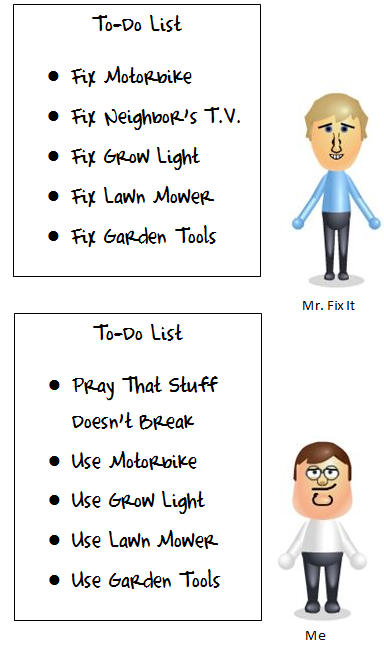
Which Light is Best for You?
Now that you understand some of the pros and cons of LEDs you can probably decide which type of grow light best fits your situation (don’t worry I won’t be offended if you choose HIDs—they are great lights). That being said, people sometimes ask me for recommendations. I’m going to outline some common situations I see and give my personal recommendation (The stories you are about to read are true. Only the names have been changed to protect the innocent).
![]()
Carl’s number one concern is the amount of Vegetable X he produces. He doesn’t care if he has to set up some elaborate system to get the job done. He doesn’t care about his electricity bill or heating. He just wants some Vegetable X, and lots of it. For people like Carl I would recommend traditional HIDS.
If your number one priority is production (and you don’t care much about any other factors), then I strongly recommend you go with traditional HIDs. My fellow LED comrades will probably be angry at me for saying this, but the truth is LEDs can’t currently (emphasis on currently) produce the same amount of vegetables (or whatever you’re growing) as HIDs. You get a bit more “bang for your buck” with an HID.
![]()
Jane is trying to grow some vegetables in her bedroom. She doesn’t really have much space for an intricate heating system. Jane is really concerned about heating. She doesn’t want to burn her house down or her plants. For people like Jane I would recommend an LED system.
If you are in a situation where heat is an issue, then I strongly recommend going with LED grow lights. I think that even proponents of HIDs would agree with this. If you are growing in a small area where it would be difficult to set up fans and a heating system, then stick with the LEDs.
![]()
Jim has about $50 to his name and nothing more. Jim desperately wants to grow Vegetable Y. For some reason Jim can’t grow outdoors. For people like Jim I recommend going with an HID system.
If you are extremely strapped for cash right now, but you really want to grow, then HIDs are the right choice.
![]()
Bill happens to have some money saved up, but he doesn’t think he’ll have as much income in the future. Bill really wants to save on energy bills. For people in Bill’s situation I’d recommend LED grow lights.
If you have a good chunk of change right now and want to save on your electricity and heating bills in the future, then I recommend going with an LED.

Peter hates fixing things and he doesn’t understand machinery very well. He doesn’t want a bunch of cords running everywhere. For people like Peter I recommend the LEDs.
If you want something that you simply have to plug in and you don’t want to worry about ballasts, fans, cooling devices, reflectors, and other technical equipment, then I recommend the LED.
I realize that some of these situations are over-generalizations. The truth is that in some cases it might be best to mix and match (half HID and Half LED). Hopefully now you have a better idea of where you fall.
Conclusion
The best advice I can give you right now is to make a decision and start growing. You aren’t going to hurt my feelings if after reading this you decide that HIDs are better for your situation. I honestly think that right now, it’s about half and half. For half of the growers out there HIDs are probably a better fit. For the other half LEDs are probably a better fit. I think in the future LEDs will be a better fit for more and more people (maybe like 75% LED and 25% HID). Choose the one that fits your situation, get away from the computer, and start growing. If you do decide that LEDs are a better fit for you, then I recommend reading the next article in this series: Qualities of Good LED Lights.


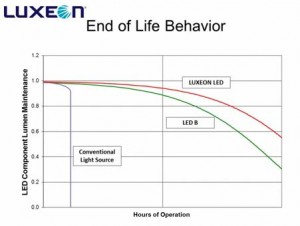
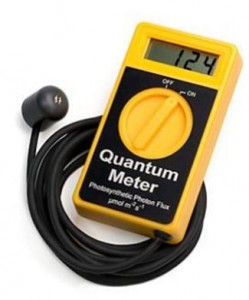
I am looking for a light for 3 orchids I am trying to get to flower (one did once and the others were purchased without blooms). I like the idea of the LEDs but have not seen anything yet that is not huge and commercial looking. Are there smaller bulbs that can do the job? Can it be housed in a simple clip light?
Ivy,
Thanks for the great question. I’m working on a post that will address concerns like yours. Give me some time to get organized and I’ll get the post up on my site. I’ll come back here and let you know when it’s done.
Thanks for stopping by.
Best,
Nate
would it be a good idea to go to my local electronics store to buy the LEDs and make the lamp by myself? i went an checked the price and it’s around 30 cents per LED (600nm) + resistor (that’s 75 dlls for a 250 LED lamp!! 😮 ), but i was wondering if they have to be some kind of special leds or so. Thanks in advance.
Hey John,
Thanks for the great question. I just wrote up a 1,200 word post to answer it, but it won’t be released on my site until the 17th. Here’s the quick answer:
What are you growing? If you are growing super tiny plants, then you might be able to get away with the type of light you are mentioning. Or if you are just using the light for the vegetation stage of your plant.
Most grow lights these days are using 3-watt diodes. The ones you can pick up at the local electronic shop are normally only 5mm diodes. They really aren’t meant for growing plants.
Now, the thing you have to ask yourself is can you make a better light than the $50 lights on Amazon? Here is a link to a bunch of LED grow lights that are less than $100 on Amazon. Can you make something better than them for $75?
I would say that 9 out of 10 people couldn’t make something better for cheaper.
Thanks for stopping by!
Nate
I understand that HID lights lose intensity over their life so that a lamp that is still lighting may not yield proper spectrum after X number of hours of use. Do LED lamps suffer this same effect or are they good until they burn out? Also, can you expect individual elements to burn out over time? Are there graphs provided by LED makers that predict output over time?
Hey Me 2 You,
Excellent question. So good that I think I need to write up a detailed article on it and let all my readers know the answer. The article will be posted on my site within the week. I’ll come back here and add a link to it then. I’ll send you an email as well.
Thanks for the great question. I’m off to write up the answer!
Nate
I am wondering about LED vs HID for seed starting, not growing the full plant indoors. I am assuming your examples were for growing indoors 100%. I want to start seeds indoors, and have done so with just light coming in from the patio door but they get spindly, and then transplant them outside when the time comes for them survive outside. What would be the best setup for this? Thanks!
You are absolutely right. LED grow lights are not always the correct solution. But there are two area where high intensity LED grow light out perform all others.
The first is a grow closet or grow cabinet. In both of these cases a HID light will turn the small space into an oven and right size flourescent grow lights just don’t fit.
The second is seed sprouting. A good LED grow light will produce far more targeted light per square inch than a flourescent light and unlike HID lights that need to be 3′ or more away, the light can be placed inches from your young sensitive seedlings with no risk of burning.